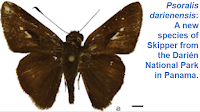Lycaenid Butterflies or 'Blues' are a widespread and highly successful group of Lepidopteran Insects, noted for their blue or metallic colouring. With about 6000 known species, Lycaenids are found on all continents and comprise about 30% of all described Butterfly species. The group is particularly notable for its relationship with Ants, with the females of many species laying their eggs in or near to Ant nests, and the young of many species being able to induce the Ants to feed them while they mature within the nest. This relationship appears to have mutualistic roots, with some members of the group having larvae which are guarded by the Ants while they feed, and which produce a sugar-rich honeydew which the Ants consume. Silverlines, Cigaritis spp., are a genus of Lycaenid Butterflies found across Africa, South and Southeast Asia.
In a paper published in the journal Entomon on 31 December 2023, Ramasamy Kamaya Naicker of Saptur Palace and the Vanam Trust, Sujitha Prabhakaran Chandrika of the Department of Zoology at the University of Kerala, Baiju Kochunarayanan of Sreerangam, Jebine Jose of Kaduvathookil House, Manoj Kripakaran of Shyladhri, Rajkumar Chidambaram Palaniappan, also of the Vanam Trust, Vinayan Padmanabhan Nair of Nethaji Housing Colony, Kalesh Sadasivan of Greeshmam and the Travancore Nature History Society describe a new species of Cigaritis from the southern Western Ghats of India.
The new species is named Cigaritis meghamalaiensis, where 'meghamalaiensis' means 'from Meghamalai' , in reference to the region where it was discovered; the name 'Meghamalai' means 'cloud mountain', so the name also refers to the subtropical montane cloud forests where the species is found. The species was first observed at high elevations within the Periyar Tiger Reserve in Kerala State, and subsequently also found in the adjoining Meghamalai Mountain Range of Tamil Nadu.
Males of Cigaritis meghamalaiensis have forewings that are black on the upper side with extensive metallic blue markings, and hindwings that are grey with blue markings. In females the forewings are grey with metallic blue markings and the hindwings are a lighter grey with blue markings. In both sexes the undersides of the wings in both sexes are a pale pinkish brown with pinkish orange markings.
Butterflies were observed flying between December and June, although they were surprisingly reluctant to the wing, making them easy prey to Spiney Lizards and other predators. They were found only on the fringes of subtropical evergreen forests. Females were observed to fly around trees with populations of predatory Acrobat Ants, Crematogaster spp.. Mating was observed in April, and eggs were laid between April and December, on the bark of trees and shrubs such as Neolitsea spp. and Clerodendrum infortunatum, always in the presence of Crematogaster wroughtonii Ants, either in dark crevices on the stems or directly in the Ants' nests.
Larvae were observed in 'pens' under the bark of the trees, where they were tended by Crematogaster wroughtonii Ants. These pens each contained 3-4 larvae, and appeared to be constructed specifically by the Ants, away from their own nests. This suggests that the relationship is mutual rather than parasitic, with the Ants gaining some benefit from the relationship, possibly consuming some product produced by the caterpillars.
See also...










